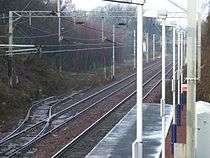Bishopton railway station
Bishopton railway station serves the village of Bishopton in Renfrewshire, Scotland. The station is on the Inverclyde line, 13 miles (21 km) west of Glasgow Central. It opened on 29 March 1841.[2] The station is managed by Abellio ScotRail.
| Bishopton | |
|---|---|
| Scottish Gaelic: Baile an Easbaig[1] | |
.jpg) Bishopton station viewed from Station Road. The train is bound for Glasgow Central. | |
| Location | |
| Place | Bishopton |
| Local authority | Renfrewshire |
| Coordinates | 55.9024°N 4.5009°W |
| Grid reference | NS437705 |
| Operations | |
| Station code | BPT |
| Managed by | Abellio ScotRail |
| Number of platforms | 2 |
| Live arrivals/departures, station information and onward connections from National Rail Enquiries | |
| Annual rail passenger usage* | |
| 2014/15 | |
| 2015/16 | |
| 2016/17 | |
| 2017/18 | |
| 2018/19 | |
| History | |
| 29 March 1841 | Opened |
| World War II | Lengthened platforms for ROF Bishopton |
| National Rail – UK railway stations | |
| |
Services
Bishopton is served by five services per hour (off-peak, Mon-Sat): four to/from Gourock, and one to/from Wemyss Bay with five per hour in the other direction to and from Glasgow Central (three limited stop expresses and two all stops locals). Evenings see a halving of services to Gourock and a reduction to 3tph to Glasgow.[3]
On Sundays there are two trains per hour to Glasgow Central and hourly services to both Wemyss Bay and Gourock. The rolling stock used is predominantly Class 380 EMUs but there is the occasional Class 314 EMU.
| Preceding station | Following station | |||
|---|---|---|---|---|
| Langbank | Abellio ScotRail Inverclyde Line |
Paisley St James | ||
| Historical railways | ||||
| Langbank | Caledonian Railway Glasgow, Paisley and Greenock Railway |
Georgetown Line open; station closed | ||
ROF sidings
There was a standard gauge link from the ROF railway line to the Inverclyde line. The factory had transfer sidings connected to both the up and down lines. The ROF line which was never electrified ran on to the transfer sidings a few yards west from the Bishopton station. It crossed Ingleston Road via a gated level crossing entering the ROF site from the north. The link remained in-situ right up until closure of the factory but was little used after the early 1990s. The sidings were removed in 2011.
Accident
A passenger train from Glasgow to Greenock was leaving the station on the morning of 16 January 1855. A mineral train travelling on the other line in the opposite direction approached and as the trains passed each other, trucks at the rear of the mineral train left the rails. They fell on the up line as the passenger train was coming. This resulted in the passenger train stopping quickly. Nobody was killed, however twelve mineral wagons were damaged.[4]
Gallery
 Bishopton station (1961)
Bishopton station (1961).jpg) A Glasgow bound train departing
A Glasgow bound train departing ROF transfer sidings
ROF transfer sidings
Sources
- Butt, R. V. J. (1995). The Directory of Railway Stations: details every public and private passenger station, halt, platform and stopping place, past and present (1st ed.). Sparkford: Patrick Stephens Ltd. ISBN 978-1-85260-508-7. OCLC 60251199.
- Jowett, Alan (March 1989). Jowett's Railway Atlas of Great Britain and Ireland: From Pre-Grouping to the Present Day (1st ed.). Sparkford: Patrick Stephens Ltd. ISBN 978-1-85260-086-0. OCLC 22311137.
References
- Brailsford, Martyn, ed. (December 2017) [1987]. "Gaelic/English Station Index". Railway Track Diagrams 1: Scotland & Isle of Man (6th ed.). Frome: Trackmaps. ISBN 978-0-9549866-9-8.CS1 maint: ref=harv (link)
- "Bishopton History: It's been a while". Inbishopton.org.uk. Archived from the original on 30 July 2014. Retrieved 25 July 2014.
- Table 219 National Rail timetable, May 2016
- "Accident at Bishopton on 16th January 1855". The Railways Archive. Retrieved 21 May 2014.